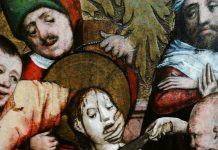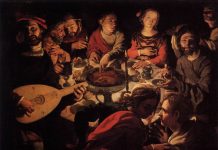The Italian journalist and Catholic convert Vittorio Messori in 1985 published his two hundred page interview with Joseph Cardinal Ratzinger, the future Pope Benedict XVI, under the title The Ratzinger Report. Thirty-four years later it is worthwhile to be reminded of where the Church was then, according to its future pope, so that we might begin to compare it with where it is today. At the time of the interview Cardinal Ratzinger was Prefect of the Congregation for the Doctrine of the Faith, a position of authority in the Catholic Church second only to Pope John Paul II. The principal task of this Prefect is to keep intact the traditional teachings of the Church and to guard them against the encroachment of heresy. Cardinal Ratzinger was fully aware that the new world-wide wave of skepticism commencing in the 1960s (simultaneous with Vatican II) had infected many Catholics. To a great extent they had “lost sight of the essence of the Church.” The Magisterium at Vatican II had in fact produced documents that became the targets of rebellious theologians within the next twenty years, provoking eminent lay Catholic philosophers Jacques Maritain and Dietrich von Hildebrand, among others, to complain of the collective bolt from orthodoxy.
The Problem Stated
The leaders of those “many” who have lost their way were theologians (the blind leading the blind?) who reserved for themselves the right to interpret official Church teaching according to their own willful escape from the Magisterium’s authority. Without mentioning names, Ratzinger deftly concluded regarding these off-the-rail theologians: Today one frequently opposes one’s own theological hypothesis to the Magisterium by asserting that the teaching office does not express the faith of the Church but only ‘the archaic Roman theology.’ … I wonder at the adroitness of theologians who manage to represent the exact opposite of what is written in clear documents of the Magisterium in order afterwards to set forth this inversion with skilled dialectical devices as the ‘true’ meaning of the documents in question.
Indeed, according to Ratzinger, a deliberate frustration of the fruits of Vatican II swept through the Church: namely, a “progressive progress of decadence” that resulted in foiling the very benefits expected from the Council, and all this under the guise of interpreting the “spirit of the Council” rather than the true documents the Council had produced. Ratzinger analyzed the progressive forces outside the Church as partly complicit in foiling the work of Vatican II, but he also pointed to trends by Church theologians (again, without naming names) determined to collaborate with each other in discrediting the documents of Vatican II. The present obligation of the Church would be to rediscover those documents in order to “cut the ground from under these false protests.” It is clear, then, that Vatican II must not be blamed for anything, but rather must be studied again to clarify what was intended to result from it.
It seemed to Ratzinger that too many Catholics after Vatican II were seduced by the worldwide culture that opposed the spirit of the world to the spirit of the Church. Many mistakenly believed that Vatican II was the opening to ratify in certain ways the spirit of the world, when it fact it intended to challenge that spirit and bring it into conformity with the spirit of Christ, which certainly was not the spirit of the world. If that mission is to be accomplished it will require Catholics to assert the same spirit that has always guided the Church, and never suppose that Vatican II was about “correcting” that spirit so that it might be brought into conformity with the world. Therefore, if “restoration” of the Church was called for, it was not restoration of the Church in all things to where it was before Vatican II, but rather restoration of the Church to its eternal mission of saving souls by opposing the spirit of the world that was seeking to overcome the Church both from within and from without. It is in fact possible, and even necessary, that the Church restore herself by returning to the great documents of Vatican II, and by exposing them to sunlight rather than allowing them to be ignored or buried so that an excuse could be found to oppose the very word and spirit of those documents.
The Problem of the Priests
According to Ratzinger, Pope John XXIII had called the Council neither to define doctrines nor to reform the Church, but to refresh it and bring about a new synthesis and unity of purpose that would be most ecumenical. John XXIII was surprised at certain turns the Council took, away from his own intent. But since John’s papacy a crisis of faith has truly developed. The source of this crisis Ratzinger puts very bluntly: “a crisis of priests and religious orders.” Why suddenly did the seminaries and convents go empty? It needs to be remembered that by the late 1960s in the Western World a great wave of skepticism had taken hold. In part this skepticism was abetted by all the typical institutions that were of a liberal or “progressive” stripe. In politics, in the media, and in academia young men were being seduced by the siren song of relativism that was reaching into every corner of the life of every generation, but particularly the young. As it so happens, Christ was neither a skeptic nor a relativist. What Christ was, and remains, is a King, whose teachings are not subject to question nor to human reform. Thus, the traditional dogmas of the Church, which are absolute, and which are always proclaimed and defended by priests and religious orders, came to be regarded by many of the young as no longer relevant or consistent with “modern” values, which are viewed by the culture at large as subject to change and so-called “progress.”
Likewise, we observe the rapid exodus of men from the priesthood. Why? Ratzinger comments: Such a man, in the end, can grow weary of resisting, with his words and even more with his life-style, the seemingly so reasonable realities that are accepted as a matter of course and that characterize our culture. The decline in the Sacrament of Reconciliation seemed to Ratzinger consistent with this decline among priests of the sense of the sacred mystery of the presence of Christ in their lives. The old style of confession came to be displaced by a new, conversational and more casual or therapeutic approach. Ratzinger emphasizes: Rather, it is much more necessary that the priest be willing to remain in the background, thus leaving space for Christ, who alone can remit sins. (The old darkened box confessional seemed to put the shadow of the priest in the background, so that the priestly “I” who absolves the sins of the penitent gives space to the felt presence of Christ, who is the real absolving “I.”)
The Problem of the Bishops
Ratzinger begins by noting that the bishops collectively with the pope constitute the Magisterium, the teaching authority granted by Christ to the Church through her apostles and their successors to this day. A singular development that is not in the constituted authority of the Church is the fact of regional or national episcopal conferences. These conferences can have no collective binding authority over the Church as a whole. For Ratzinger, “they have only a practical, concrete function.” This practical and concrete function can sometimes get too complicated for its own good, as bishops quarrel among themselves about governance. Ratzinger notes this happened, for example, in Nazi Germany, when certain bishops spoke up against wrongdoing, but the German bishops’ conference as a whole tended to be “too wan and too weak” to be effective.
Ratzinger was firm on insisting that bishops exercise their apostolic duty according to their conscience, and not according to the prevailing winds of preference found among other bishops or society at large. He noted that some bishops admit to following the lead of other bishops (or even theologians?), and thus abandon their consecrated duty and authority to find the truth and proclaim it. He then cites the apostle Paul: Refute falsehood, correct error, call to obedience…. The time is sure to come when, far from being content with sound teaching, people will be avid for the latest novelty and collect for themselves a whole series of teachers according to their tastes; and then, instead of listening to the truth, they will turn to myths. (2 Timothy 4:1-5.) What Paul is clearly defining here is the principle of orthodoxy that must prevail everywhere in the Church, and which principle the bishops are bound to defend.
A Shattered Catechesis
The new habit among theologians of being “creative” has given rise to a collapse of catechesis. No longer do we have a harmonic and whole catechesis by which a universal (catholic) doctrine can be preached. Some passages of Scripture are emphasized, while others are ignored, thus fragmenting what should be a whole and consistent doctrine. Two years earlier, Ratzinger had noted: “The first grave error in this direction was to suppress the catechism, and to declare quite universally that the category ‘catechism’ was quite obsolete.” Ratzinger then relates that in France a mother complained that her son was being taught much theory about Q (a supposed early collection of Jesus’ sayings never proven to exist) but that he learned nothing about the seven sacraments and the Apostles’ Creed. This absence of real catechesis can only end with Catholics poorly informed and at sea about what the Church teaches.
Doubting Scripture
Ratzinger points to the decline of faith in the divinity of Jesus among some Catholic theologians, as if the Arian heresy of the fourth century had returned to undermine true Christology. Doubts arise too regarding the Real Presence, the virginity of Mary, the reality of Adam and Eve and original sin, the Resurrection of Jesus, and the resurrection of all humans at the end of history. He finds most disconcerting the Freudian challenge to God as Father, since “Freud mistrusts every father and all fatherhood.” It is unfortunate that science in so many ways has challenged the biblical account of creation and original sin, because to do so is to challenge at the same time the need for redemption from that sin which Christ provided. Theologians who (like Teilhard de Chardin) see our perfection in some kind of natural evolutionary movement toward human betterment, have been seduced to repudiate the very essence of Christianity, which is to rely upon Christ’s death on the cross as a proof that if we are to be saved from our fallen state, “… it is necessary to abandon oneself to Love.”
Moral Relativism
There wasn’t any doubt for Ratzinger that even before Vatican II some Catholic theologians had moved from a liberal to a permissive view of morals. The dominant culture, which is hardly Christian, has exerted an influence on Catholic theologians who have aligned themselves with it. Pointing to the fact that all societies enlist the aid of human reason to decide moral issues, these theologians decide that even the Decalogue of Moses and the teachings of Jesus are supported by reason. But this is not precisely true. The truths taught by Moses and Christ are supported by divine fiat. This is why they are uniquely beyond the reach or generation of reason alone. But once the seed is planted, it grows. For some theologians, reason usurps the age-old teachings of the Magisterium, just as it usurped the warning of God in the Garden of Eden, when the serpent persuaded Adam and Eve that God reasoned to deny them equality with Him by denying them the fruit of the tree. The serpent’s reasoning became theirs, and so reason alone is not the best or only guide to morals.
The same problem emerged with theological resistance to traditional teachings on sexuality. As Ratzinger puts it regarding certain theologians:
I should like to cite some trends: at times premarital relations, at least under certain conditions, are justified. Masturbation is presented as a normal phenomenon of adolescence. Admission of remarried divorced couples to the sacraments is constantly demanded…. Even as regards the question of homosexuality, attempts at its justification are in the making. Indeed, it has come to pass that bishops – on the basis of insufficient information or also because of a sense of guilt among Catholics toward an ‘oppressed minority’- have placed churches at the disposal of ‘gays’ for their gatherings. Then there is the case of Humanae Vitae, the encyclical of Paul VI, which reaffirmed the ‘no’ to contraceptives and which has not been understood. Instead it has been more or less openly rejected in broad ecclesial circles.”
Clearly Ratzinger sees a kind of creeping moral relativism promoted by so-called liberal theologians.
Feminism in Theology
Ratzinger was adamant about the natural differences between men and women, and descried the modern tendency to blur those difference by demanding equality in all things. Even the right to a sex change operation, which denies God’s directed plan for our human destiny, seems to him a perverse overturn of the divine plan that can only result in delusional self-fulfillment. The sad fact is that woman has bought into the notion that she can only be fulfilled by sharing equality with man; this too is delusional because it asserts the acquirement of male advantages without male responsibilities, and moreover puts the female in the unnatural position of shouldering both female (reproduction) and male (provider) burdens. [This would go toward explaining why more women choose not to have children, and why more men who want to have children choose not to mate with these same women.] And so, he concludes, I am in fact convinced that what feminism promotes in its radical form is no longer the Christianity that we know, but another religion. Echoing natural law ethics, Ratzinger adds, To respect biology is to respect God himself, hence to safeguard his creatures.
The Devil and His Trail
Ratzinger rejects certain modern theologians’ views that the devil is not a person but a metaphor for evil. Pope Paul VI is cited for his authoritative remarks: “The devil is the enemy number one, the source of all temptation. Thus we know that this dark and destructive being really exists and is still active; he is the sophistical perverter of man’s moral equipoise, the malicious seducer who knows how to penetrate us (through the senses, the imagination, desire, utopian logic, or disordered social contacts) in order to spread error” The devil is everywhere and, as Paul VI said, the smoke of Satan has even entered the Temple of God through some crack or other.
While the power of Satan is still great, the power of Christ is infinitely greater, so that Christ has been a comfort to Christians against the snares of the devil. Yet for non-Christians the reality of Satan is so far removed from their consciousness that Satan has a greater power over them. Ratzinger comments further: There are already signs of the return of these dark powers, and Satanic cults are spreading more and more in the secularized world. Ratzinger’s position is that the more recent theologians, who have tried to turn Satan into an abstract concept or force rather than a person one, are dead wrong. The evangelists had it right when they presented demons as personal beings in the Gospels, and no amount of fancy theological footwork can change that.
[As a sidebar, the current Superior General of the Jesuits, Arturo Marcelino Sosa Abascal, has remarked, “We have created symbolic figures, such as the devil, in order to express (the reality of) evil.” But another Jesuit, Pope Francis, does not concur. “This generation, and many others, have been led to believe that the devil is a myth, a figure, an idea, the idea of evil. But the devil exists, and we must fight against him.”]
The Path to Ecumenism
On the subject of ecumenism that arose out of Vatican II, Ratzinger was clear. Ecumenism must not mean watering down Catholicism so that Protestants and Catholics could get nearer to each other, though some Catholic theologians seem to have adopted that posture. Going down that path will only get us farther away from true ecumenism. Protestantism (except for certain sects) since its inception has gradually morphed into the adopted child of the secular world. This is the heritage of Luther, whose rebellion started down the trail of all future modern and secular protests against the eternal Catholic values that the Church’s mission is to protect. Sola Scriptura itself, by which Protestantism in general has managed to provide hundreds of conflicting interpretations, and therefore hundreds of differing Christian churches, has become the critical factor dividing Catholics and Protestants. Yet, Ratzinger insists, he has enjoyed “friendship with truly spiritual Protestants, people whom I greatly respect.” Although Ratzinger saw some movement on the part of Protestants to recognize the authority of tradition, as opposed to scripture alone, he believed it would be hard if not impossible … to accept the priesthood as a sacrament and an indispensable precondition for the Eucharist.
As for the eastern Orthodox Churches, ecumenism with them has not progressed significantly, and these Churches seem to have remained doctrinally petrified since the first Christian millennium. While they recognize priesthood and authority, and dialogue with them is possible, the sticking point is that they deny the final authority of Peter and the popes of Rome. Nor has there been significant progress in relations with Anglicanism, part of which has remained more or less orthodox, but much of which has moved not closer to Rome since Vatican II (once thought very possible), but farther away with the ordination of women priests and other distancing in moral theology. Moreover, mainstream Protestants, especially the Lutherans, have their own Bible translations which vary in parts from the Catholic translations. Attempts to find a “common Bible” have failed and will continue to fail, since, even though some Protestants have come to recognize the Bible as a product of the early Catholic Church. Some Protestant scholars, like Heinrich Schlier, become Catholics when they begin to realize that the Bible is thoroughly Catholic.
Liberation Theology
By the year of Ratzinger’s interview, liberation theology had become a topic of controversy among theologians, and Ratzinger did not hold back. Liberation theology was viewed, especially in South America, as a theology to be preached for human liberation from poverty and want. What the Dominicans and Jesuits had not counted on, apparently, was that the Marxists would be the competing liberators from poverty and want. Liberation theology of the Marxists had been dedicated in Europe to liberating the human soul from God and religion. Marxism had failed on a fundamental level, and so had moved its locus of activity to South America. When he read liberation theologians, this is what he was disappointed to hear:
A continual refrain is this: ‘Man must be liberated from the chains of politico-economic oppression; the reforms are not enough to liberate him, indeed they lead away from liberation; what is necessary is revolution, and the only way to bring about a revolution is to summon the people to the class struggle.’ Yet those who repeat all this seem to have no concrete and practical idea how a society could be organized after the revolution. They limit themselves to repeating that the revolution must be brought about…. It is also painful to be confronted with the illusion, so essentially un-Christian which is present among priests and theologians, that a new man and a new world can be created, not by calling each individual to conversion, but only by changing the social and economic structures. For it is precisely personal sin that is in reality at the root of unjust social structures.
But Ratzinger sees as much moral failure in the opulent West as he sees in third-world countries. They too need a theology of liberation, as Ratzinger puts it:
(T)here is a sign of the Satanic in the way in which people exploit the market for pornography and drugs in the West…. There is something diabolical in the cold-blooded perversity with which man is corrupted for the sake of money and profit drawn from his weakness, his temptability and vulnerability in the face of temptation. Western culture is hellish when it persuades men that the sole aim of life is pleasure and self-interest.”
Post Script 1
Something like this paradigm shift has occurred in the Catholic Church since Cardinal Ratzinger’s interview of 1985, except that it has occurred in ways one might least expect. Whereas for 2,000 years Catholic Church doctrines (if not always practices) were the paragon of moral orthodoxy, some Catholic moral theologians today seem to have fallen off the orthodox bandwagon. Not only have there been ongoing sex scandals among the clergy, but Cardinals and Bishops have been defrocked (even sentenced to prison) for the violations of their sacred trust. For two decades there has been a tiresome and discouraging litany of sex scandals. In the United States alone more than a billion dollars have been spent on law suits, thus squandering reservoirs of cash that might have been spent on missionary activities and the poor. Worst of all, the thousands of victims of sex abuse (the actual number can never be calculated) are destined to live broken lives, any number of them losing faith in the moral authority of the Church, and others leaving the Church or drifting away through declining confidence in Her divine mission to save, rather than destroy. It is as if Josef Stalin was reaching out of his grave to continue his plot of wrecking the Catholic Church by sending a Trojan Horse full of saboteur priests into it to spread an immoral and all-consuming moral cancer.
Conduct is one thing, doctrine is quite another. As mentioned earlier, raising questions about whether hell and devils actually exist has been considered by some liberal theologians. Even when the doctrines are not openly disputed, they are barely mentioned on the altar (sometimes they are mentioned with a wink or a chuckle, as if the congregation could take them cum graino salto as remnants of medieval superstition). Catechesis for several decades has been in a deplorable state. Parents cannot pass on to their children what they do not have because they have not been adequately taught. Surveys indicate that the majority of Catholics no longer believe in the Real Presence. Unless it is a Mass specifically scheduled for the young, a dwindling supply of young people are seen in the pews.
As Barbara Nicolosi has noted: We have to stop the madness. We have to stop lying about how bad this problem is because we don’t want to cause a stir and hurt feelings. The Church in our century is dying of a malaise that comes from ignorance. People aren’t praying because they don’t know anything about God. They aren’t evangelizing because they don’t know what they have to share. And, to top it off, heaven forbid that parishes should revive the art and science of apologetics; so that when the young go off to college, they at least have some inkling of how to overcome the seductive arguments of their mostly atheistic or agnostic professors.
Perhaps my chronic and sad pessimism is the predictable hazard of old age; on the other hand, it might be a way to take stock of a civilization in decline, for only by admitting to dangerously debilitating problems can one begin to solve them. There is one almighty thing we can count on to refuel optimism at last.
God is on our side.
Post Script 2
Having cleared his intent with Pope Francis, Emeritus Pope Benedict has published a 6,000 word document titled “The Church and the Scandal of Sexual Abuse” in which he seeks to partly explain the origin of the clerical sex scandals. In particular, he notes the sexual revolution epidemic of the 1960s which followed on the heels of Vatican II. About that time both natural law ethics and moral absolutes were tossed out the theological windows and replaced with a dictatorship of moral relativism which infected even the seminaries, as seminarians formed homosexual clubs and were even shown pornographic movies! It was inevitable that in such a milieu of immorality the seedbeds of todays’ clerical abuses would be planted.
But, in point of fact, as I have already noted in “The Trojan Horse in the City of God” (December 9, 2018) the genesis of these horrors was much earlier than the post Vatican II era. The original seedbeds were planted at the direction of Josef Stalin, who, formerly a seminarian and later an atheistic socialist, sought to undermine the Catholic Church by recruiting immoral and faithless seminarians to become Catholic priests. Clerical scandals in the American Church reach back long before Vatican II (indeed for centuries) and became epidemic in modern times as a consequence of the several factors noted by Pope Benedict.












